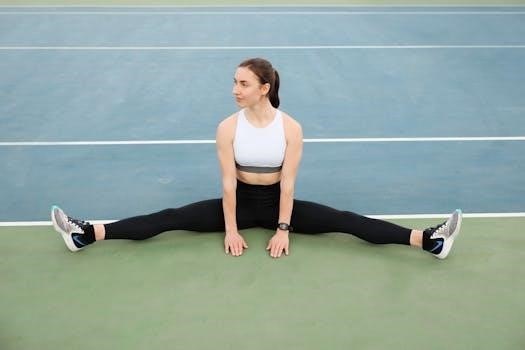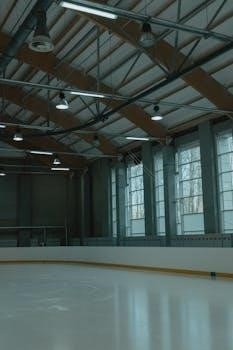elbow rom exercises pdf
Elbow Range of Motion Exercises⁚ A Comprehensive Guide
This guide provides a detailed overview of elbow range of motion (ROM) exercises. These exercises are designed to improve flexibility, reduce stiffness, and restore function in the elbow joint. Whether you’re recovering from an injury or surgery, or simply seeking to enhance your elbow health, this guide offers valuable insights and practical exercises.
Elbow range of motion exercises are crucial for maintaining and restoring the functionality of the elbow joint. These exercises are particularly beneficial following injuries, surgeries, or conditions that limit movement, such as fractures or contractures. The primary goal is to improve flexibility, reduce stiffness, and alleviate pain, ultimately enhancing the overall quality of life.
This comprehensive guide will explore various types of elbow ROM exercises, including active, passive, and those utilizing tools like Therabands. Active exercises involve self-initiated movements, while passive exercises require external assistance. Theraband exercises add resistance to further strengthen the muscles surrounding the elbow joint.
Regularly performing these exercises can significantly improve the elbow’s ability to bend and straighten fully. This is essential for performing everyday tasks, such as lifting, reaching, and grasping. Furthermore, consistent ROM exercises can prevent long-term complications, such as chronic pain and limited mobility. This guide will provide step-by-step instructions and helpful tips to ensure safe and effective execution of each exercise.
Understanding Normal Elbow Range of Motion
To effectively address limitations in elbow movement, it’s essential to understand the normal range of motion (ROM). A healthy elbow should allow for complete extension, straightening the arm fully, and flexion, bending the arm to bring the fingertips towards the shoulder. This range is typically described in degrees, with full extension being 0 degrees and full flexion around 135 to 150 degrees.

Normal elbow function also includes pronation and supination, which are the rotational movements of the forearm. Pronation involves turning the palm downwards, while supination involves turning the palm upwards. These movements are crucial for various daily activities and should be considered when assessing overall elbow function.
Factors such as age, activity level, and underlying medical conditions can influence an individual’s normal ROM. However, significant deviations from the typical range may indicate an issue requiring attention. Understanding these norms helps in identifying restrictions and tracking progress during rehabilitation. Evaluating both flexion-extension and pronation-supination provides a comprehensive picture of elbow health, guiding the selection of appropriate exercises and interventions.

Causes of Limited Elbow Range of Motion
Limited elbow range of motion can stem from a variety of underlying causes, often resulting in pain, stiffness, and difficulty performing everyday tasks. One of the most common culprits is injury, such as fractures, dislocations, or soft tissue damage to ligaments, tendons, or muscles surrounding the elbow joint. These injuries can lead to inflammation, scar tissue formation, and subsequent restriction of movement.
Arthritis, including osteoarthritis and rheumatoid arthritis, can also significantly impact elbow ROM; The degenerative changes and inflammation associated with arthritis can erode cartilage, causing pain and stiffness that limit joint mobility. Post-operative stiffness is another frequent cause, particularly after elbow surgery, where scar tissue and swelling can hinder normal movement.
Furthermore, conditions like contractures, where muscles or soft tissues shorten and tighten, can restrict elbow ROM. This can occur due to prolonged immobilization, neurological conditions, or as a result of burns. Finally, nerve injuries affecting the muscles controlling elbow movement can also contribute to limitations. Identifying the specific cause is crucial for developing an effective treatment plan aimed at restoring optimal elbow function and range of motion.
Active Elbow Range of Motion Exercises
Active elbow range of motion exercises involve using your own muscle strength to move your elbow joint through its full range of motion. These exercises are crucial for maintaining and improving flexibility, reducing stiffness, and promoting healing after an injury or surgery. Before starting any exercise program, it’s essential to consult with a healthcare professional to ensure it is appropriate for your specific condition.

One common exercise is elbow flexion and extension. Simply bend your elbow as far as comfortably possible, bringing your hand towards your shoulder, and then straighten your arm completely. Repeat this movement several times, focusing on achieving the fullest range of motion without causing pain.
Another important exercise is forearm pronation and supination. With your elbow bent at a 90-degree angle, turn your palm upwards (supination) and then downwards (pronation). Perform this movement slowly and deliberately, ensuring you feel the stretch in your forearm muscles. These active exercises encourage blood flow, strengthen supporting muscles, and help restore normal elbow function. Consistency and proper form are key to maximizing benefits and preventing further injury.
Passive Elbow Range of Motion Exercises
Passive elbow range of motion (PROM) exercises involve using an external force, such as your other hand or a therapist’s assistance, to move your elbow joint. These exercises are particularly beneficial when you have limited ability to move your elbow on your own due to pain, stiffness, or weakness. PROM exercises help maintain joint flexibility, prevent contractures, and improve circulation.
A common PROM exercise is elbow flexion and extension. Using your unaffected hand, gently bend your affected elbow as far as comfortable, holding the stretch for a few seconds. Then, slowly straighten your elbow, again holding the stretch. Ensure that you are not forcing the movement beyond a comfortable range to avoid causing pain or further injury. You can also use a towel or strap to assist in gently pulling your elbow into flexion or extension.
Another valuable PROM exercise focuses on forearm pronation and supination. With your elbow supported, use your unaffected hand to gently rotate your forearm, turning your palm upwards (supination) and downwards (pronation). These passive movements help to maintain the mobility of the forearm muscles and joints. Regular PROM exercises, performed correctly, can significantly contribute to restoring elbow function and reducing stiffness.
Elbow Range of Motion Exercises with Theraband
Theraband exercises are a great way to enhance elbow range of motion and strength. Therabands provide resistance, allowing you to gradually increase the challenge as your elbow recovers or improves. These exercises focus on strengthening the muscles surrounding the elbow joint, promoting stability and flexibility.
For elbow flexion, secure one end of the Theraband under your foot and hold the other end with your hand, palm facing up. Slowly bend your elbow, pulling against the resistance of the band. Control the movement as you lower your arm back down. Similarly, for elbow extension, secure the band above you and hold the other end, starting with your elbow bent. Slowly straighten your elbow, extending against the band’s resistance. Remember to maintain a controlled motion throughout the exercise.

To work on forearm pronation and supination, sit with your elbow bent at 90 degrees and your forearm resting on a table. Hold one end of the Theraband in your hand and anchor the other end. Rotate your forearm, turning your palm up (supination) and then down (pronation), against the resistance of the band. These Theraband exercises are essential for comprehensive elbow rehabilitation and improved function.
Chair Exercises for Elbow Range of Motion
Chair exercises are a safe and effective way to improve elbow range of motion, especially for individuals with limited mobility or those recovering from injuries. These exercises can be easily performed while seated, providing support and stability.
One simple exercise is seated elbow flexion and extension. Sit upright in a chair with your feet flat on the floor. Slowly bend your elbow, bringing your hand towards your shoulder, and then straighten your arm back down. Repeat this motion several times, focusing on controlled movements. Another chair exercise involves forearm rotation. With your elbow bent at 90 degrees and your forearm resting on your thigh, gently rotate your forearm, turning your palm up and then down. This exercise helps improve pronation and supination.
You can also perform assisted elbow stretches while seated. Use your unaffected arm to gently guide your affected arm through a greater range of motion. For example, use your good arm to help bend your affected elbow further than it can normally go. Remember to listen to your body and avoid pushing past the point of pain. Chair exercises are a convenient way to maintain or improve elbow flexibility and function.
Importance of Rehabilitation After Elbow Fractures
Rehabilitation plays a crucial role in the recovery process following an elbow fracture. Elbow fractures often lead to stiffness, reduced range of motion, and decreased strength. Without proper rehabilitation, these limitations can become chronic, significantly impacting daily activities and overall quality of life. The primary goal of rehabilitation is to restore optimal elbow function.
Early rehabilitation focuses on pain management and reducing swelling through modalities like ice and elevation. As healing progresses, the emphasis shifts to regaining range of motion through gentle exercises. Active and passive range of motion exercises are essential for preventing stiffness and promoting tissue healing. Strengthening exercises are gradually introduced to rebuild muscle strength and stability around the elbow joint.
A structured rehabilitation program, guided by a physical therapist or hand specialist, ensures that exercises are performed correctly and safely. The therapist can also provide manual therapy techniques to address joint stiffness and muscle tightness. Adhering to a prescribed rehabilitation plan is vital for achieving the best possible outcome after an elbow fracture, minimizing long-term complications, and returning to desired activities.
Role of a Hand Specialist in Elbow Rehabilitation
A hand specialist, often a hand surgeon or a certified hand therapist, plays a vital role in the comprehensive rehabilitation of elbow injuries and conditions. These specialists possess in-depth knowledge of the complex anatomy and biomechanics of the upper extremity, enabling them to provide tailored treatment plans to optimize recovery.
Hand specialists conduct thorough evaluations to accurately diagnose the underlying cause of elbow pain and dysfunction. They assess range of motion, strength, stability, and neurological function to identify specific impairments. Based on this assessment, they develop individualized rehabilitation programs that address the patient’s unique needs and goals. These programs often include specialized exercises, manual therapy techniques, and modalities to reduce pain, improve mobility, and restore function.
Furthermore, hand specialists can fabricate custom orthoses, such as splints or braces, to protect the elbow, promote healing, and prevent further injury. They also educate patients on proper body mechanics, activity modification, and injury prevention strategies. Their expertise ensures that patients receive the most effective and evidence-based care, maximizing their chances of a successful recovery and return to their desired activities.
Shirley Ryan AbilityLab and Translational Research in Elbow Rehabilitation
The Shirley Ryan AbilityLab stands as a pioneering institution in the realm of rehabilitation, particularly renowned for its commitment to translational research. This approach bridges the gap between scientific discovery and clinical practice, ensuring that the latest advancements are rapidly integrated into patient care, including elbow rehabilitation.
At the AbilityLab, clinicians, scientists, innovators, and technologists collaborate within the same space, fostering a dynamic environment for the real-time application of research findings. This collaborative spirit facilitates the development of novel therapies and interventions tailored to improve outcomes for individuals with elbow injuries and conditions. Their research efforts focus on understanding the biomechanics of the elbow, developing innovative rehabilitation protocols, and utilizing advanced technologies to enhance recovery.
The AbilityLab’s dedication to translational research extends to the development and validation of new assessment tools and outcome measures, ensuring that rehabilitation interventions are both effective and efficient. By continually pushing the boundaries of knowledge and innovation, the Shirley Ryan AbilityLab is transforming the landscape of elbow rehabilitation, empowering individuals to achieve their fullest potential.
